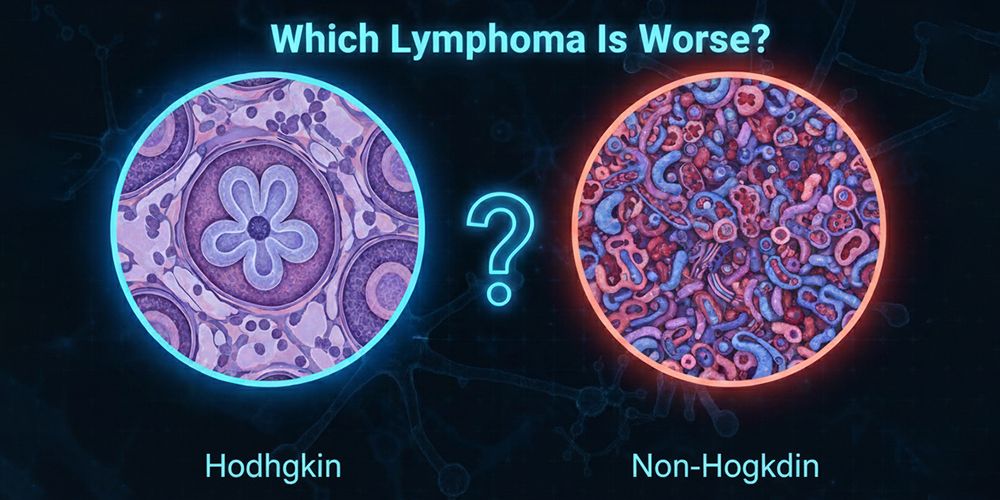
Have you ever found yourself wondering which lymphoma is worse? It’s a question many people ask after hearing about Hodgkin and non-Hodgkin lymphoma. We understand how confusing it can feel when doctors mention these medical terms. Since lymphoma affects the blood and immune system, learning about it helps you make better decisions for yourself or someone you care about.
In this blog, we’ll explain what lymphoma means, the key differences between Hodgkin and non-Hodgkin lymphoma, and what makes one type more serious than the other. We’ll also talk about how lymphoma is diagnosed, its relation to genetics, and the role of clinical research.
What Is Lymphoma
Lymphoma is a type of blood cancer that begins in the lymphatic system, which is part of our immune defense. The lymphatic system includes the lymph nodes, bone marrow, spleen, and other organs that help fight infections.
In lymphoma, white blood cells called lymphocytes grow uncontrollably and start to form lumps or tumors. Furthermore, these abnormal cells can become metastatic, which means they can travel through the body and affect many organs.
On the other hand, you might have also heard about lymphoproliferative disorders, which refers to the abnormal growth of lymph cells. These conditions are not always cancer at first, but if left untreated, some can turn into lymphoma over time. That’s why regular checkups and early diagnosis matter so much.
Hodgkin vs Non-Hodgkin Lymphoma: Which Is Worse
Many people ask, which is worse, Hodgkin’s or Non-Hodgkin’s Lymphoma. The truth is, both types have their own patterns, treatment options, and outcomes.
Hodgkin lymphoma is less common but often easier to treat. This is because it usually starts in a single group of lymph nodes and spreads in an orderly way. Many patients respond well to chemotherapy or radiation and can go into long-term remissions.
On the other hand, non-Hodgkin lymphoma (NHL) is more common and includes many subtypes. Some grow slowly, while others are aggressive and need faster treatment.
So, when we talk about Hodgkin VS Non-Hodgkin Lymphoma, one isn’t always “worse” than the other. Instead, what matters most is the exact subtype, the stage when it’s found, and how well it responds to treatment.
How We Define “Worse” in Lymphoma
When people ask which lymphoma is worse, they often mean which one is more aggressive or life-threatening. To understand that, we’ll take a look at a few important points:
- Speed of growth: Some lymphomas grow slowly and may not cause symptoms for years, while others spread quickly.
- Treatment response: Some subtypes respond better to treatment than others.
- Survival rates: Hodgkin lymphoma has a high cure rate, while certain aggressive non-Hodgkin types are harder to treat.
However, with advances in treatment and research, many people with both types live long, fulfilling lives.
Types of Lymphoma and Their Risks
Among non-Hodgkin lymphomas, two well-known subtypes often come up in research:
- Diffuse Large B-Cell Lymphoma (DLBCL): This is an aggressive but potentially curable form of NHL. Many patients do well with timely chemotherapy. Some also explore Diffuse Large B Cell Lymphoma clinical trials to access new treatments.
- Follicular Lymphoma: This type grows more slowly but can return after treatment. Therefore, ongoing Follicular Lymphoma clinical trials are testing new targeted therapies that may control it better in the future.
Summary
| Lymphoma Type | Growth Speed | Treatment Response | Long-Term Outlook |
|---|---|---|---|
| Hodgkin | Moderate | Excellent | Often curable |
| Diffuse Large B-Cell (NHL) | Fast | Good with early treatment | Many achieve remission |
| Follicular (NHL) | Slow | Fair, but relapses are possible | Manageable long-term |
This table shows that “worse” depends on the type, not just the label.
How Is Lymphoma Diagnosed
Knowing how lymphoma is diagnosed is very important, because early detection makes a big difference. Doctors usually start with the following diagnostic methods:
- Physical examination to check for swollen lymph nodes.
- Blood tests to study cell counts and organ function.
- Imaging scans, such as CT or PET, to find where the disease has spread.
- Lymph node biopsy, which confirms the exact type of lymphoma.
Sometimes, a bone marrow test or genetic analysis is also done to plan the right treatment.
Signs That Point to Lymphoma
Lymphoma may look like:
- Painless swelling in the neck, armpit, or groin.
- Tiredness or fatigue that doesn’t go away.
- Fever or night sweats without an obvious cause.
- Unexplained weight loss over a short period.
These symptoms can happen with other health problems, too. However, if they continue for more than two weeks, it’s best to see a doctor for a proper evaluation.
To learn more about signs of lymphoma, Click Here.
Is Lymphoma Genetic or Hereditary
In most cases, lymphoma is not directly inherited. It usually develops due to changes in immune function or exposure to certain infections.
However, genetics can still play a small role. If someone in your family has lymphoma, your risk might be slightly higher, but it doesn’t mean you will get it. Moreover, research is being conducted to understand whether lymphoma is genetic or hereditary and how genes and environment can simultaneously play a role in causing lymphoma.
Lymphoma Compared to Other Blood Cancers
When we look at different types of blood cancers as a group, a common question arises; which is worse, leukemia or lymphoma? The answer mostly depends on the subtype and stage of either cancer.
Leukemia affects the bone marrow and blood, while lymphoma affects the lymphatic system. Some leukemias progress faster, but certain lymphomas can also act aggressively.
Thus, if you’re wondering which type of blood cancer is most dangerous, it’s difficult to rank them. Aggressive non-Hodgkin types and acute leukemias are often the most serious, but early treatment improves survival in many cases.
Also Read: What is Blood Cancer? Types, Causes & Symptoms
The Role of Clinical Research
At NHO Revive, we believe research brings hope. Through our ongoing clinical research studies in Nebraska, we focus on developing better treatments for lymphoma and other blood cancers. Every study gives doctors new data and patients access to therapies that may not yet be widely available.
Clinical research is the reason why many untreatable cancers now have multiple effective therapies. By joining or supporting research, you become part of progress that helps patients around the world while also experiencing the benefits of participating in oncology clinical trials, such as access to new treatments and closer medical monitoring.
Conclusion
So, which lymphoma is worse? The honest answer is that it depends. Hodgkin lymphoma often responds very well to treatment and has high cure rates. Whereas non-Hodgkin lymphoma varies widely, with some subtypes being more aggressive than others.
No matter the type, early diagnosis, the right treatment plan, and access to research-based options make a huge difference.
Furthermore, NHO Revive is proudly conducting hematology oncology clinical researches that explore new treatments for different types of blood cancers like lymphoma. Our goal is to bring patients closer to better care and more treatment options.
Thus, if you or a loved one has been affected by lymphoma, reach out to learn more about our ongoing studies and how you can be part of advancing cancer research.







